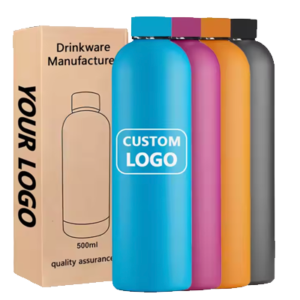Can Stainless Steel Cups Be Made Into Any Shape?
As a stainless steel drinkware manufacturer, we get this question a lot: “Can stainless steel cups be made into any shape?”
It’s a fair question—just take a look around. From sleek hourglass tumblers to wide-bottomed mugs and minimalist geometric bottles, stainless steel cups today come in a dazzling variety of forms. But here’s the thing: stainless steel isn’t exactly the most flexible material to work with. So how do we achieve all these complex, seamless designs?
The answer lies in a powerful piece of manufacturing technology: hydroforming.
Hydroforming—also known as the water expansion process—has revolutionized how we shape stainless steel, allowing for greater design freedom, fewer welds, and smoother surfaces.
Table of Contents
ToggleWhat Is Hydroforming, Exactly?
Hydroforming is a specialized metal forming process that plays a key role in stainless steel cup manufacturing. Instead of relying on traditional mechanical force to punch or press the metal into shape, hydroforming uses high-pressure water as the forming medium.
Here’s how it works: a stainless steel tube is sealed inside a mold, and water is injected into the cavity at extremely high pressure. This water pressure is applied evenly across the entire surface of the metal, gently but powerfully forcing it to expand and take the shape of the mold. The result? A seamless, three-dimensional part with precise curves and contours—perfect for beautifully shaped cups and bottles.
What makes hydroforming different from stamping or forging is its principle of “soft force conquering hard material.” By converting mechanical force into fluid pressure, hydroforming avoids many of the problems caused by stress concentration in traditional processes—like cracking, wrinkling, or uneven thickness. Instead, the material flows smoothly against the mold walls, creating complex forms with high dimensional accuracy. This makes hydroforming a go-to technique not just in drinkware, but also in aerospace, automotive, and medical equipment manufacturing.
There are two main types of hydroforming molds used in cup production:
1. Vertical Die (Plug-Type Hydroforming)
This mold features a vertical alignment between the top punch (core rod) and the pressure chamber. Water is injected through a small hole in the rod, pushing the metal outward in one axial direction. It’s ideal for forming symmetrical, vertically stretched parts—like the threaded neck of a thermos cup.
Why use it? It’s cost-effective, easy to control, and great for simple, single-direction shapes.
2. Split Die (Two-Piece Mold)
This type of mold splits horizontally into two halves, forming a fully enclosed cavity when closed. Water pressure is applied from all directions, allowing the metal to expand 360 degrees. This setup is perfect for creating multi-directional curves and complex shapes, such as grooved cup bodies or sculpted waistlines—all in a single forming cycle.
Why use it? It offers maximum design freedom and precision, but the mold is more complex and expensive to produce, and the process requires tighter control over water pressure distribution.
Each method has its own strengths: the vertical die is faster and more cost-efficient for simpler shapes, while the split die excels at handling high-end, design-driven cup bodies. As manufacturers, we carefully match the hydroforming method to the product’s design complexity and production volume—balancing technical capability with commercial value.
But It’s Not Without Limitations
As powerful and versatile as hydroforming is, it’s not a one-size-fits-all solution. Like any advanced manufacturing method, it comes with trade-offs—and understanding those trade-offs is key to making the right decisions in product development and production planning.
1. Higher Mold and Equipment Costs
Hydroforming requires specially designed molds that can withstand extreme internal water pressure, along with precision hydraulic equipment to maintain that pressure during forming. These molds—especially two-piece split dies for complex shapes—are more expensive to design and produce than those used in simpler processes like stamping. That’s why hydroforming is best suited for medium to large production runs where the initial investment can be spread across volume.
2. Not Ideal for All Shapes or Designs
While hydroforming excels at creating smooth curves and organic forms, it’s not ideal for every type of cup structure. Designs that require internal parts, sharp edges, or external attachments (like welded handles or decorative shells) may still rely on traditional fabrication methods. Some shapes are simply too intricate—or too functionally demanding—for hydroforming alone to handle.
3. Precision Pressure Control Required
Because the process relies on high-pressure water, even small variations in pressure or seal quality can lead to inconsistent results. Overpressure may rupture the metal, while underpressure could cause incomplete forming or wrinkling. Manufacturers need to fine-tune every parameter—material thickness, mold fit, pressure curve, and sealing—especially when dealing with thin-walled or intricately shaped products.
4. Longer Setup Times
Compared to simpler processes like stamping or spinning, hydroforming typically requires more setup time per new product. This includes mold alignment, pressure calibration, and sealing system checks. For low-volume custom orders or frequent product changes, this can lead to longer production cycles and slower time-to-market.
In short, hydroforming isn’t a silver bullet—but when applied to the right products and with the right planning, it can dramatically elevate both design and manufacturing quality. As a manufacturer, our role is to weigh these pros and cons carefully, matching each production method to the specific needs of the project. Sometimes that means combining hydroforming with other processes, or choosing an entirely different route based on cost, complexity, or functional requirements.
So, can stainless steel cups be made into any shape? The short answer is: almost. With advanced techniques like hydroforming, we can unlock an impressive level of design freedom—producing seamless, durable, and uniquely shaped drinkware that stands out on the shelf and in the hand. But like any process, it works best when applied thoughtfully, with a clear understanding of its strengths and limits.
At Haers, we specialize in bringing custom stainless steel bottles ideas to life. Whether you’re looking for a bold new silhouette, functional detailing, or something that’s never been done before, our engineering team can help you explore the right manufacturing process to match your design and budget.
If you have a custom shape in mind or want to learn more about what’s possible with hydroforming and other techniques, feel free to reach out. We’re always happy to talk design, materials, and the future of drinkware—one shape at a time.
→ Contact us to discuss your next custom stainless steel cup project.


